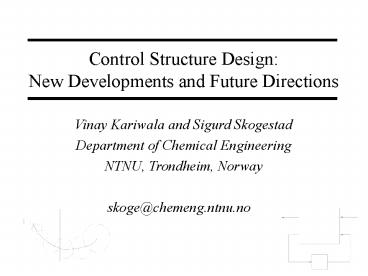Control Structure Design: New Developments and Future Directions - PowerPoint PPT Presentation
Title:
Control Structure Design: New Developments and Future Directions
Description:
2. Control Structure Design. Challenges. Tools (partial ... Kandepu et al., Proceedings of SIMS, Trondheim, Norway, 2005. 24. Extra Manipulated Variables ... – PowerPoint PPT presentation
Number of Views:107
Avg rating:3.0/5.0
Title: Control Structure Design: New Developments and Future Directions
1
Control Structure Design New Developments and
Future Directions
- Vinay Kariwala and Sigurd Skogestad
- Department of Chemical Engineering
- NTNU, Trondheim, Norway
skoge_at_chemeng.ntnu.no
2
- Control Structure Design
- Challenges
- Tools (partial solutions)
- Case Studies
- Future Directions
3
Control Systems
Truly Optimal
Optimizing Controller
d
u
ym
Process
4
Control Structure Design Structural Decisions
Truly Optimal
Ph.D. Control
PID Control
Optimizing Controller
Economic Optimizer
Local Optimizer
d
zset
d
Process
Process
Regulatory Controller
zset
Controller
5
Previous Work
- Buckley (1964)
- Umeda et al. (1978)
- Fisher et al. (1988)
- Price, Georgakis et al. (1993)
- McAvoy and Ye (1994)
- Luyben et al. (1997)
- Ng and Stephanopolous (1998)
We want a generic approach that is mathematically
well-formulated and extends beyond process
control
6
- Control Structure Design
- Challenges
- Tools (partial solutions)
- Case Studies
- Future Directions
7
Challenges
- Q1. What should be controlled?
- Choice depends on operational objectives -
- usually steady-state economics
- Often the most important decision
Local Optimizer
zset
Supervisory Controller
y2,set
Regulatory Controller
u
ym
Process
8
Challenges
Q1. What should be controlled?
Local Optimizer
zset
- Q2. What variables should be used for
- regulatory control?
- Hundreds of measurements
- Lack of precise mathematical formulation
Supervisory Controller
y2,set
Regulatory Controller
u
ym
Process
9
Challenges
Q1. What should be controlled?
Local Optimizer
zset
Q2. What variables should be used for regulatory
control?
Supervisory Controller
y2,set
- Q3. To decentralize or not? If yes, how?
- Pairing selection or process decomposition
- Usually an issue for supervisory layer
Regulatory Controller
u
ym
Process
10
- Control Structure Design
- Challenges
- Tools (partial solutions)
- Case Studies
- Future Directions
11
Q1. What should be controlled?
Local Optimizer
- Self-optimizing control
- Control active constraints
- Unconstrained Control variables that give
- acceptable loss when held constant
zset
Supervisory Controller
y2,set
Regulatory Controller
u
ym
Process
12
Q1. What should be controlled?
Local Optimizer
- Self-optimizing control
- Control active constraints
- Unconstrained Control variables that give
- acceptable loss when held constant
zset
Supervisory Controller
y2,set
Regulatory Controller
u
ym
Process
13
Q1. What should be controlled?
Local Optimizer
- Self-optimizing control
- Control active constraints
- Unconstrained Control variables that give
- acceptable loss when held constant
zset
Supervisory Controller
y2,set
Regulatory Controller
u
ym
Process
14
Q1. What should be controlled?
Local Optimizer
- Self-optimizing control
- Control active constraints
- Unconstrained Control variables that give
- acceptable loss when held constant
zset
Supervisory Controller
y2,set
- Brute force evaluation
- Locally optimal methods
- Maximum gain rule max
- Combination of measurements
Regulatory Controller
u
ym
Process
Skogestad. J. Proc. Control, 2000 Halvorsen,
Morud, Skogestad and Alstad. Ind. Eng. Chem. Res.
2003 Ph.D. Thesis of M. Govatsmark and V. Alstad,
NTNU, Norway
15
Regulatory layer
Local Optimizer
zset
Supervisory Controller
y2,set
Prevent the runner from falling (Separation of
tasks)
Regulatory Controller
u
ym
- Objectives regulatory control
- Stabilization
- Disturbance rejection
Process
16
Q2a. Variables for stabilization?
Choose variables that minimize input usage
- Reduced likelihood of input saturation
- Least disturbing effect on stabilized system
17
Q2b. Variables for Disturbance Rejection
Local
r
Disturbance
-
Rejection
n
u
-
2
y2
Stabilized
d
System
z
u
1
With y2 controlled
Choose variables to reduce disturbance sensitivity
18
Sequential Approach
Primary CVs Economically self-optimizing
z
System
1.
u
19
- Control Structure Design
- Challenges
- Tools (partial solutions)
- Case Studies
- Future Directions
20
Applications
- Traditional
- Chemical plants
- Aerospace and mechanical systems
- Emerging
- Fuel cells
- Bioreactors
- Systems biology
21
Example Binary Distillation Column
1. Primary CVs (self-optimizing) z Top and
Bottom compositions
22
Example Binary Distillation Column
2b. Disturbance rejection y2 Temperature
on Tray 15 u2 Vapor Boilup
23
Example Solid Oxide Fuel Cell
24
Extra Manipulated Variables
Disturbance sensitivity Fresh fuel, Air Bypass
25
Performance Evalution
Inputs are also within bounds
26
- Control Structure Design
- Challenges
- Tools (partial solutions)
- Case Studies
- Future Directions
27
Controller Complexity
- Minimize controller complexity subject to the
achievement of accuracy specifications in the
face of uncertainty. (Nett, 1990) - How to define controller complexity?
- Number of non-zero elements of controller
- Number of tuning parameters
- How to consider it during structure selection?
Nobakhti, Proceedings of ISIC MED, 2005
28
Computational Aspects
Alternatives
Problem size
Millions of Alternatives
29
Conclusions Remaining Challenges
- Controller complexity
- Definition, inclusion in selection procedure
- Computational aspects
- Integer variables, Non-convexity, Multi-objective
- NP-hardness (Integrity problem)
- Non-linear systems
- Most of theory Linear systems
- Time-scale separation
- Speeds of layers
30
Control Structure Design New Developments and
Future Directions
- Vinay Kariwala and Sigurd Skogestad
- Department of Chemical Engineering
- NTNU, Trondheim, Norway
skoge_at_chemeng.ntnu.no































